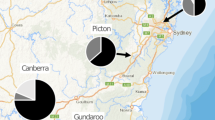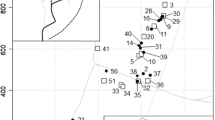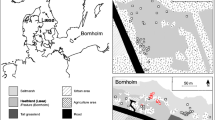Abstract
In ants, reproductive division of labour is typically associated with queen-worker dimorphism. In some species with ergatoid queens (wingless worker-like queens), this polymorphism is drastically reduced and virgin queens may integrate the worker force. While ergatoid queens have been described in several species, their colony and population genetic structure remain largely unstudied. Here, we investigated the population structure and sociogenetic organisation of the desert ant Ocymyrmex robustior. All Ocymyrmex species have only ergatoid queens that are worker-sized. Workers, queens, and males from a large population were genotyped at ten polymorphic microsatellite loci. Our results show that the study population is genetically structured, consistent with dependent colony foundation. Genetic analyses revealed that 17.6% of the males were diploid; diploid males are fertile, siring triploid females. Nests were typically headed by a single queen, and queens were strictly monandrous. However, several nests in the population shared matrilines, indicating polygyny, polydomy, dependent colony foundation, serial polygyny, or a combination of these processes. Dissections reveal that workers lay eggs in both queenright and queenless nests, while virgin ergatoid queens lay eggs in queenright nests only. However, our genetic analyses show that male offspring in queenright nests are all queen-produced, suggesting worker policing and/or trophic egg laying.


Similar content being viewed by others
Data accessibility
The microsatellite data set supporting this article is available on the online version of this paper, as part of the electronic supplementary material (ESM_3).
References
Amor F, Villalta I, Doums C, Angulo E, Caut S, Castro S, Jowers MJ, Cerdá X, Boulay R (2016) Nutritional versus genetic correlates of caste differentiation in a desert ant. Ecol Entomol 41:660–667
André JB, Peeters C, Doums C (2001) Serial polygyny and colony genetic structure in the monogynous queenless ant Diacamma cyaneiventre. Behav Ecol Sociobiol 50:72–80
Aron S, Mardulyn P, Leniaud L (2016) Evolution of reproductive traits in Cataglyphis desert ants: mating frequency, queen number, and thelytoky. Behav Ecol Sociobiol 70:1367–1379
Baer B, Schmid-Hempel P (1999) Experimental variation in polyandry affects parasite loads and fitness in a bumble-bee. Nature 397:151–154
Blacket MJ, Robin C, Good RT, Lee SF, Miller AD (2012) Universal primers for fluorescent labelling of PCR fragments—an efficient and cost-effective approach to genotyping by fluorescence. Mol Ecol Resour 12:456–463
Bolton B (1981) A revision of six minor genera of Myrmicinae (Hymenoptera Formicidae) in the Ethiopian Zoogeographical Region. Bull Br Mus Nat Hist Zool, Entomol ser (UK)
Bolton B, Marsh AC (1989) The Afrotropical thermophilic ant genus Ocymyrmex (Hymenoptera: Formicidae). J Nat Hist 23:1267–1308
Boomsma JJ (2007) Kin selection versus sexual selection: why the ends do not meet. Curr Biol 17:673–683
Boomsma JJ (2009) Lifetime monogamy and the evolution of eusociality. Philos Trans R Soc Lond B: Biol Sci 364:3191–3207
Boomsma JJ (2013) Beyond promiscuity: mate-choice commitments in social breeding. Philos Trans R Soc Lond B: Biol Sci 368:20120050
Boomsma JJ, Ratnieks FLW (1996) Paternity in eusocial Hymenoptera. Philos Trans R Soc London Ser B 351:947–975
Boomsma JJ, Kronauer DJC, Pedersen JS (2009) The evolution of social insect mating systems. In: Gadau J, Fewell J (eds) Organization of insect societies. Harvard University press, Cambridge, pp 3–25
Boulay R, Aron S, Cerdá X, Doums C, Graham P, Hefetz A, Monnin T (2017) Social life in arid environments: the case study of Cataglyphis ants. Annu Rev Entomol 62:305–321
Bourke AF, Franks NR (1995) Social evolution in ants. Princeton University Press, Princeton, 550 pp
Bourke AF, Heinze J (1994) The ecology of communal breeding: the case of multiple-queen leptothoracine ants. Phil Trans R Soc Lond B 345:359–372
Brown MJ, Schmid-Hempel P (2003) The evolution of female multiple mating in social Hymenoptera. Evolution 57:2067–2081
Cahan SH, Vinson SB (2003) Reproductive division of labor between hybrid and nonhybrid offspring in a fire ant hybrid zone. Evolution 57:1562–1570
Cahan SH, Parker JD, Rissing SW, Johnson RA, Polony TS, Weiser MD, Smith DR (2002) Extreme genetic differences between queens and workers in hybridizing Pogonomyrmex harvester ants. Proc Royal Soc B 269:1871–1877
Chybicki IJ, Burczyk J (2008) Simultaneous estimation of null alleles and inbreeding coefficients. J Hered 100:106–113
Cook JM (1993) Sex determination in the Hymenoptera: a review of models and evidence. Heredity 71:421
Cournault L, Aron S (2009) Diploid males, diploid sperm production, and triploid females in the ant Tapinoma erraticum. Naturwissenschaften 96:1393
Cronin AL, Molet M, Doums C, Monnin T, Peeters C (2013) Recurrent evolution of dependent colony foundation across eusocial insects. Annu Rev Entomol 58:37–55
Crozier RH, Fjerdingstad EJ (2001) Polyandry in social Hymenoptera—disunity in diversity? Ann Zool Fenn 38:267–285
Crozier RH, Page RE (1985) On being the right size: male contributions and multiple mating in social Hymenoptera. Behav Ecol Sociobiol 18:105–115
Crozier RH, Pamilo P (1996) Evolution of social insect colonies. Oxford University Press, Oxford, 314 pp
Dai HD, Leeder JS, Cui Y (2014) A modified generalized Fisher method for combining probabilities from dependent tests. Front genet 5:32
Doums C, Ruel C, Clémencet J, Fédérici P, Cournault L, Aron S (2013) Fertile diploid males in the ant Cataglyphis cursor: a potential cost of thelytoky? Behav Ecol Sociobiol 67:1983–1993
Foitzik S, Heinze J (1998) Nest site limitation and colony takeover in the ant Leptothorax nylanderi. Behav Ecol 9:367–375
Foitzik S, Kureck IM, Rüger MH, Metzler D (2010) Alternative reproductive tactics and the impact of local competition on sex ratios in the ant Hypoponera opacior. Behav Ecol Sociobiol 64:1641–1654
Forder JC, Marsh AC (1989) Social organization and reproduction in Ocymyrmex foreli (Formicidae: Myrmicinae). Insectes Soc 36:106–115
Foster KR, Ratnieks FL (2000) Social insects: facultative worker policing in a wasp. Nature 407:692–693
Foster KR, Ratnieks FL (2001) Convergent evolution of worker policing by egg eating in the honeybee and common wasp. Proc Royal Soc B 268:169–174
Foster KR, Ratnieks FL, Gyllenstrand N, Thorén PA (2001) Colony kin structure and male production in Dolichovespula wasps. Mol Ecol 10:1003–1010
Gobin B, Peeters C, Billen J (1998) Production of trophic eggs by virgin workers in the ponerine ant Gnamptogenys menadensis. Physiol Entomol 23:329–336
Hardy OJ, Vekemans X (2002) SPAGeDi: a versatile computer program to analyse spatial genetic structure at the individual or population levels. Mol Ecol Notes 2:618–620
Harpur BA, Sobhani M, Zayed A (2013) A review of the consequences of complementary sex determination and diploid male production on mating failures in the Hymenoptera. Entomol Exp Appl 146:156–164
Hartmann A, Wantia J, Torres JA, Heinze J (2003) Worker policing without genetic conflicts in a clonal ant. PNAS 100:12346–12840
Herbers JM (1986) Nest site limitation and facultative polygyny in the ant Leptothorax longispinosus. Behav Ecol Sociobiol 19:115–122
Heimpel GE, de Boer JG (2008) Sex determination in the Hymenoptera. Annu Rev Entomol 53:209–230
Heinze J, Keller L (2000) Alternative reproductive strategies: a queen perspective in ants. Trends Ecol Evol 15:508–512
Heinze J, Hölldobler B, Alpert G (1999) Reproductive conflict and division of labor in Eutetramorium mocquerysi, a myrmicine ant without morphologically distinct female reproductives. Ethology 105:701–717
Heinze J, Smith TA (1990) Dominance and fertility in a functionally monogynous ant. Behav Ecol Sociobiol 27:1–10
Holldobler B, Bartz SH (1985) Sociobiology of reproduction in ants. In: Holldobler B, Lindauer M (eds) Experimental behavioral ecology and sociobiology. Sinauer and Associates, Sunderland, pp 237–257
Hölldobler B, Wilson EO (1990) The ants. Harvard University Press, Cambridge, 746 pp
Holleley CE, Geerts PG (2009) Multiplex Manager 1.0: a cross-platform computer program that plans and optimizes multiplex PCR. Biotechniques 46:511–517
Hughes WOH, Ratnieks FLW, Oldroyd BP (2008a) Multiple paternity or multiple queens: two routes to greater intracolonial genetic diversity in the eusocial Hymenoptera. J Evol Biol 21:1090–1095
Hughes WOH, Oldroyd BP, Beekman M, Ratnieks FLW (2008b) Ancestral monogamy shows kin selection is key to the evolution of eusociality. Science 320:1213–1216
Ito F, Ohkawara K (2000) Production and behavior of ergatoid queens in two species of the Indonesian ponerine ant genus Leptogenys (diminuta-group) (Hymenoptera: Formicidae. Ann Entomol Soc Am 93:869–873
Jones OR, Wang J (2010) COLONY: a program for parentage and sibship inference from multilocus genotype data. Mol Ecol Resour 10:551–555
Julian GE, Fewell JH (2004) Genetic variation and task specialization in the desert leaf-cutter ant, Acromyrmex versicolor. Animal Behav 68:1–8
Julian GE, Fewell JH, Gadau J, Johnson RA, Larrabee D (2002) Genetic determination of the queen caste in an ant hybrid zone. Proc Natl Acad Sci USA 99:8157–8160
Katzerke A, Neumann P, Pirk CW, Bliss P, Moritz RF (2006) Seasonal nestmate recognition in the ant Formica exsecta. Behav Ecol Sociobiol 61:143–150
Keller L (1993) Queen number and sociality in insects. Oxford University Press, Oxford, 456 pp
Keller L (1995) Social life: the paradox of multiple-queen colonies. Trends Ecol Evol 10:355–360
Kokko H, Johnstone RA, Clutton-Brock TH (2001) The evolution of cooperative breeding through group augmentation. Proc. Royal Soc. B 268:187–196
Krieger MJ, Ross KG, Chang CW, Keller L (1999) Frequency and origin of triploidy in the fire ant Solenopsis invicta. Heredity 82:142–150
Kuhn A, Bauman D, Darras H, Aron S (2017) Sex-biased dispersal creates spatial genetic structure in a parthenogenetic ant with a dependent-lineage reproductive system. Heredity 119:207–213
Kureck IM, Jongepier E, Nicolai B, Foitzik S (2012) No inbreeding depression but increased sexual investment in highly inbred ant colonies. Mol Ecol 21:5613–5623
Leniaud L, Darras H, Boulay R, Aron S (2012) Social hybridogenesis in the clonal ant Cataglyphis hispanica. Curr biol 22:1188–1193
Mariac C, Scarcelli N, Pouzadou J, Barnaud A, Billot C, Faye A et al (2014) Cost-effective enrichment hybridization capture of chloroplast genomes at deep multiplexing levels for population genetics and phylogeography studies. Mol Ecol Resour 14:1103–1113
Marsh AC (1985a) Microclimatic factors influencing foraging patterns and success of the thermophilic desert ant, Ocymyrmex barbiger. Insectes Soc 32:286–296
Marsh AC (1985b) Thermal responses and temperature tolerance in a diurnal desert ant, Ocymyrmex barbiger. Physiol Zool 58:629–636
Masella AP, Bartram AK, Truszkowski JM, Brown DG, Neufeld JD (2012) PANDAseq: paired-end assembler for illumina sequences. BMC bioinform 13:31
Mattila HR, Seeley TD (2007) Genetic diversity in honey bee colonies enhances productivity and fitness. Science 317:362–364
McGlynn TP (2010) Polygyny in thief ants responds to competition and nest limitation but not food resources. Insectes Soc 57:23–28
Meglécz E, Pech N, Gilles A, Dubut V, Hingamp P, Trilles A et al (2014) QDD version 3.1: a user-friendly computer program for microsatellite selection and primer design revisited: experimental validation of variables determining genotyping success rate. Mol Ecol Resour 14:1302–1313
Molet M, Fisher BL, Ito F, Peeters C (2009) Shift from independent to dependent colony foundation and evolution of ‘multi-purpose’ ergatoid queens in Mystrium ants (subfamily Amblyoponinae). Biol J Linnean Soc 98:198–207
Monnin T, Peeters C (1999) Dominance hierarchy and reproductive conflicts among subordinates in a monogynous queenless ant. Behav Ecol 10:323–332
Muser B, Sommer S, Wolf H, Wehner R (2005) Foraging ecology of the thermophilic Australian desert ant, Melophorus bagoti. Austral J Zool 53:301–311
Nonacs P (1988) Queen number in colonies of social Hymenoptera as a kin-selected adaptation. Evolution 42:566–580
Norman V, Darras H, Tranter C, Aron S, Hughes WO (2016) Cryptic lineages hybridize for worker production in the harvester ant Messor barbarus. Biol lett 12:20160542
Oldroyd BP, Halling LA, Good G, Wattanachaiyingcharoen W, Barron AB, Nanork P et al (2001) Worker policing and worker reproduction in Apis cerana. Behav Ecol Sociobiol 50:371–377
Pamilo P (1985) Effect of inbreeding on genetic relatedness. Hereditas 103:195–200
Pamilo P (1991) Evolution of colony characteristics in social insects. II. Number of reproductive individuals. Am Nat 138:412–433
Pamilo P (1993) Polyandry and allele frequency differences between the sexes in the ant Formica aquilonia. Heredity 70:472–480
Pearcy M, Aron S, Doums C, Keller L (2004) Conditional use of sex and parthenogenesis for worker and queen production in ants. Science 306:1780–1783
Peeters C (2012) Convergent evolution of wingless reproductives across all subfamilies of ants, and sporadic loss of winged queens (Hymenoptera: Formicidae). Myrmecological News 16:75–91
Peeters C, Tsuji K (1993) Reproductive conflict among ant workers in Diacamma sp. from Japan: dominance and oviposition in the absence of the gamergate. Insectes Soc 40:119–136
Perry JC, Roitberg BD (2006) Trophic egg laying: hypotheses and tests. Oikos 112:706–714
Queller DC, Goodnight KF (1989) Estimating relatedness using genetic markers. Evolution 43:258–275
Ratnieks FL (1988) Reproductive harmony via mutual policing by workers in eusocial Hymenoptera. Am Nat 132:217–236
Ravary F, Jaisson P (2004) Absence of individual sterility in thelytokous colonies of the ant Cerapachys biroi FOREL (Formicidae, Cerapachyinae). Insectes Soc 51:67–73
Raymond M, Rousset F (1995) An exact test for population differentiation. Evolution 49:1280–1283
Robinson EJH (2014) Polydomy: the organisation and adaptive function of complex nest systems in ants. Curr Opin Insect Sci 5:37–43
Rohland N, Reich D (2012) Cost-effective, high-throughput DNA sequencing libraries for multiplexed target capture. Genome Res 22:939–946
Romiguier J, Fournier A, Yek SH, Keller L (2017) Convergent evolution of social hybridogenesis in Messor harvester ants. Mol Ecol 26:1108–1117
Rousset F (1997) Genetic differentiation and estimation of gene flow from F-statistics under isolation by distance. Genetics 145:1219–1228
Rousset F (2008) genepop’007: a complete re-implementation of the genepop software for Windows and Linux. Mol Ecol Resour 8:103–106
Schmidt CV, Heimbucher A, Bernadou A, Heinze J (2017) First come, first served: the first-emerging queen monopolizes reproduction in the ant Cardiocondyla “argyrotricha”. J Ethol 35:21–27
Sommer S, Wehner R (2012) Leg allometry in ants: extreme long-leggedness in thermophilic species. Arthropod Struct Dev 41:71–77
Strassmann J (2001) The rarity of multiple mating by females in the social Hymenoptera. Insectes soc 48:1–13
Thorne BL (1997) Evolution of eusociality in termites. Annu Rev Ecol Evol Syst 28:27–54
Van Wilgenburg E, Driessen G, Beukeboom LW (2006) Single locus complementary sex determination in Hymenoptera: an “unintelligent” design? Front Zool 3:1
Vargo EL (2003) Hierarchical analysis of colony and population genetic structure of the eastern subterranean termite, Reticulitermes flavipes, using two classes of molecular markers. Evolution 57:2805–2818
Walsh PS, Metzger DA, Higuchi R (1991) Chelex 100 as a medium for simple extraction of DNA for PCR-based typing from forensic material. Biotechniques 10:506–513
Wehner R (1987) Spatial organization of foraging behavior in individually searching desert ants, Cataglyphis (Sahara Desert) and Ocymyrmex (Namib Desert). In JM Pasteels and J-L Deneubourg (ed) From Individual to Collective Behavior in Social Insects. Birkhäuser Basel, Switzerland, pp. 15–42
Wehner R, Wehner S (2011) Parallel evolution of thermophilia: daily and seasonal foraging patterns of heat-adapted desert ants: Cataglyphis and Ocymyrmex species. Physiol Entomol 36:271–281
Weir BS (1996) Genetic Data Analysis II. Sinauer and Associates, Sunderland
Willot Q, Simonis P, Vigneron JP, Aron S (2016) Total internal reflection accounts for the bright color of the Saharan silver ant. PloS One 11:e0152325
Acknowledgements
We thank Quentin Willot for his help on the field and Erik T. Frank for providing us the samples used for genomic library development. We are grateful to the Ministry of Environment and Tourism of Namibia (Permit No. 2268/2017) and Gobabeb Research and Training Center for granting us collection permits. This work was supported by PhD fellowships (ASP fellowship to N.L., FRIA fellowship to A.K.) as well as several grants (S.A.) from the Belgian Fonds National pour la Recherche Scientifique (FRS-FNRS).
Author information
Authors and Affiliations
Corresponding author
Electronic supplementary material
Below is the link to the electronic supplementary material.
Rights and permissions
About this article
Cite this article
Lecocq de Pletincx, N., Kuhn, A. & Aron, S. Population structure and sociogenetic organisation in a species with ergatoid queens, the desert ant Ocymyrmex robustior. Insect. Soc. 66, 389–401 (2019). https://doi.org/10.1007/s00040-019-00697-w
Received:
Revised:
Accepted:
Published:
Issue Date:
DOI: https://doi.org/10.1007/s00040-019-00697-w




